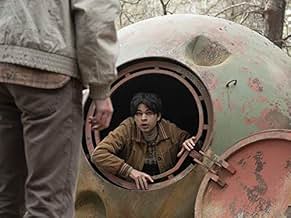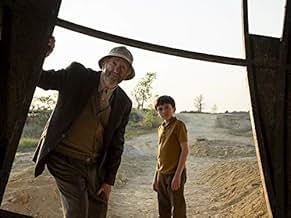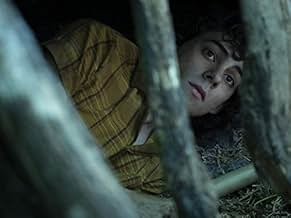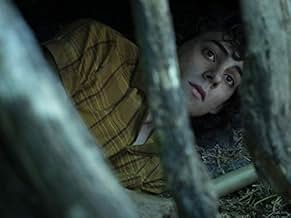Os habitantes da cidade que vivem acima de "The Loop", uma máquina construída para desvendar e explorar os mistérios do universo, experimentam coisas anteriormente consignadas ao domínio da ... Ler tudoOs habitantes da cidade que vivem acima de "The Loop", uma máquina construída para desvendar e explorar os mistérios do universo, experimentam coisas anteriormente consignadas ao domínio da ficção científica.Os habitantes da cidade que vivem acima de "The Loop", uma máquina construída para desvendar e explorar os mistérios do universo, experimentam coisas anteriormente consignadas ao domínio da ficção científica.
- Indicado para 2 Primetime Emmys
- 10 indicações no total
Explorar episódios
Resumo
Reviewers say 'Tales from the Loop' is a contemplative sci-fi series that delves into human emotions and relationships with a mysterious technological backdrop. Praised for its atmospheric depth, set design, and sound, each episode offers a unique story. The show's melancholy tone and poetic style blend sci-fi with human drama, though some find the pacing slow and narrative unclear. Acting and cinematography are generally lauded, yet certain episodes are criticized for lacking substance.
Avaliações em destaque
A rare example of what science fiction can achieve, with a subtlety in its thoughtful pacing that is rarer still. Almost certainly this was what failed to appeal to the mass market, since its languorous tempo will drive the mainstream attention-deficit audience out of their tiny minds.
Some well-worn and yet timeless themes are refreshed by gentle treatment.
Unspoken secrets (episode 1) Jealousy (episode 2) Conformity, Fear of responsibility / not wanting to grow up / peter pan syndrome? (episode 3) Existentialism (episode 4) Desire for control / overprotectiveness (episode 5) Forbidden love / possessiveness and the pleasure of its unattainability (episode 6) Guilt and Alienation (episode 7) Grief, nostalgia and the death of innocence (episode 8)
Understated, powerful performances and sympathetic acting.
Inevitably a product of its times, and so occasionally lacking in subtlety plus somewhat heavy handed in its treatment of gender politics. And there are a couple of sex scenes that are unnecessary and were better left to the imagination, not least of all because the majority of the story is suggestive instead of explicit. Perhaps it is a matter of taste.
Supposedly the series was inspired by a painting, which under normal circumstance would not be a recommendation in its favour however for those that are able to work their way through it all, you may be able to appreciate the metaphor in terms of a backdrop for powerful yet restrained drama - as in a theatre where a small number of actors demand your concentration.
Superb.
The story-writers and production team deserve great praise, and whoever it was at Amazon that made the case to purchase the series or - it is almost unimaginable to contemplate - commissioned it rather than relying on The Market to spew it out: we can all hope you get more opportunities to exercise your talents.
Some well-worn and yet timeless themes are refreshed by gentle treatment.
Unspoken secrets (episode 1) Jealousy (episode 2) Conformity, Fear of responsibility / not wanting to grow up / peter pan syndrome? (episode 3) Existentialism (episode 4) Desire for control / overprotectiveness (episode 5) Forbidden love / possessiveness and the pleasure of its unattainability (episode 6) Guilt and Alienation (episode 7) Grief, nostalgia and the death of innocence (episode 8)
Understated, powerful performances and sympathetic acting.
Inevitably a product of its times, and so occasionally lacking in subtlety plus somewhat heavy handed in its treatment of gender politics. And there are a couple of sex scenes that are unnecessary and were better left to the imagination, not least of all because the majority of the story is suggestive instead of explicit. Perhaps it is a matter of taste.
Supposedly the series was inspired by a painting, which under normal circumstance would not be a recommendation in its favour however for those that are able to work their way through it all, you may be able to appreciate the metaphor in terms of a backdrop for powerful yet restrained drama - as in a theatre where a small number of actors demand your concentration.
Superb.
The story-writers and production team deserve great praise, and whoever it was at Amazon that made the case to purchase the series or - it is almost unimaginable to contemplate - commissioned it rather than relying on The Market to spew it out: we can all hope you get more opportunities to exercise your talents.
This is show is incredibly stylish. Beautifully made. A real work of art. Its really great to see a show of this caliber being produced today, in the age of the short attention span. Granted, you have to be in a certain mood. I watched it over a extended period. If you're patient, it will certainly reward you.
Some episodes are better than others. I tend to agree with the individual rating on each. It's not overly complex. Each episodes has its own simple story line, strong in concept. Perhaps not each story is entirely unique in the realms of science fiction, but in this particular setting, it does feel new. It doesn't rely on effects either, so it's strong concepts may give it a long life.
A breath of fresh air and an absolute pleasure to watch. Sadly I think the TikTok generation won't be watching in droves so we may not see a second season. At least there is this. A real achievement.
Some episodes are better than others. I tend to agree with the individual rating on each. It's not overly complex. Each episodes has its own simple story line, strong in concept. Perhaps not each story is entirely unique in the realms of science fiction, but in this particular setting, it does feel new. It doesn't rely on effects either, so it's strong concepts may give it a long life.
A breath of fresh air and an absolute pleasure to watch. Sadly I think the TikTok generation won't be watching in droves so we may not see a second season. At least there is this. A real achievement.
The retro-futuristic and immeasurably cozy paintings of Simon Stålenhag have been given life by Amazon Prime. Thanks to my dad, who obtained the Tales from the Loop artbook (org. title Ur Varselklotet) when it was brand new (he may even have donated to its crowdfunding campaign), I've had a good look into Stålenhag's dreamlike alternate past before.
My brother once referred to Stålenhag's peculiar art style as "Sweden punk", where we'll scan our eyeballs over familiar rural environments until, suddenly, some sort of technological behemoth appears. It may be a strange, defunct machine (that nevertheless looks as if Volvo or Stiga could realistically design it) next to a quaint Scandinavian meadow, or a vast spacecraft hovering over a dimly lit torp in the December twilight.
Amazon brings all of this to life with an anthology, each episode nonetheless set in the same continuity, directed by the likes of Andrew Stanton and Jodie Foster (a good choice after her work on Black Mirror) and scored in part by Philip Glass - his haunting, repetitive-but-beautiful tunes as distinctive as ever. The cast includes Jonathan Pryce and Rebecca Hall, who put it best when she said in an interview that the characters genuinely seem to inhabit a universe larger than themselves. The landscape around them clearly has history, even when it isn't expositorily stated.
On that note, the "retro" part of the retro-futurism is also in the characters, including young children who are often more astute than the adults - it shares this with Stranger Things, another nostalgic streaming-original, but I currently think Tales from the Loop is better, partly because of how farcical Things has gotten. Early on, Loretta (Abby Ryder Fortson) and Cole (Duncan Joiner) are curious of the mysteries surrounding The Loop, a scientific facility in their area that seems to dabble in the unnatural.
One of the problems I had with the series is that, possibly due to the episodic structure, certain big revelations seem to come quite early in the show's run. Let me elaborate: In the very first episode, we learn something shocking about two of the main characters, akin to one of the most existentially devastating twists in the Netflix masterpiece Dark, but since we don't yet know these people that well, it isn't as impactful as it could have been. Instead, the second episode moves on to a different (somewhat better-acted) story involving the effects of The Loop, starring a tertiary character from the prior story.
However, accepting the show and the format for what it is, 'tis certainly a charming expedition into the mind of Stålenhag. The book and the artwork are faithfully adapted (including the way the characters are cast, then costumed and groomed) by head writer and developer Nathaniel Halpern, but I gather Stålenhag himself was heavily involved (complete with an on-screen cameo). He even submitted a title card animation, pictured above, "as a suggestion" and they wound up using it.
It just warms my hollow ribcage when an artist gets to realize their vision in this manner, aided by people who demonstrably give a damn. Tales from the Loop, not unlike the Netflix series Love, Death + Robots, is one of those shows that truly prove what a safe space the streaming world is for auteurs, enabled to enrich us with something new instead of sticking to a marketable studio-imposed formula.
If shows like these become successful enough, ginormous studios may learn that providing something new and original is the way to go (people sometimes argue that recent Lucasfilm and Marvel movies do represent an artist's vision, hence their controversy compared to other "factory-made" sequels, but I remain skeptical that Disney would truly allow freedom, or deem controversy as anything other than useful PR). I will certainly do my part and tell you this much: please check out Tales from the Loop. It's a visually inventive and fun watch that touches on the "larger" life questions that sci-fi concepts ought to bring. The dialogue itself can be a bit obvious and some stories may be less intriguing than others, but no matter.
My brother once referred to Stålenhag's peculiar art style as "Sweden punk", where we'll scan our eyeballs over familiar rural environments until, suddenly, some sort of technological behemoth appears. It may be a strange, defunct machine (that nevertheless looks as if Volvo or Stiga could realistically design it) next to a quaint Scandinavian meadow, or a vast spacecraft hovering over a dimly lit torp in the December twilight.
Amazon brings all of this to life with an anthology, each episode nonetheless set in the same continuity, directed by the likes of Andrew Stanton and Jodie Foster (a good choice after her work on Black Mirror) and scored in part by Philip Glass - his haunting, repetitive-but-beautiful tunes as distinctive as ever. The cast includes Jonathan Pryce and Rebecca Hall, who put it best when she said in an interview that the characters genuinely seem to inhabit a universe larger than themselves. The landscape around them clearly has history, even when it isn't expositorily stated.
On that note, the "retro" part of the retro-futurism is also in the characters, including young children who are often more astute than the adults - it shares this with Stranger Things, another nostalgic streaming-original, but I currently think Tales from the Loop is better, partly because of how farcical Things has gotten. Early on, Loretta (Abby Ryder Fortson) and Cole (Duncan Joiner) are curious of the mysteries surrounding The Loop, a scientific facility in their area that seems to dabble in the unnatural.
One of the problems I had with the series is that, possibly due to the episodic structure, certain big revelations seem to come quite early in the show's run. Let me elaborate: In the very first episode, we learn something shocking about two of the main characters, akin to one of the most existentially devastating twists in the Netflix masterpiece Dark, but since we don't yet know these people that well, it isn't as impactful as it could have been. Instead, the second episode moves on to a different (somewhat better-acted) story involving the effects of The Loop, starring a tertiary character from the prior story.
However, accepting the show and the format for what it is, 'tis certainly a charming expedition into the mind of Stålenhag. The book and the artwork are faithfully adapted (including the way the characters are cast, then costumed and groomed) by head writer and developer Nathaniel Halpern, but I gather Stålenhag himself was heavily involved (complete with an on-screen cameo). He even submitted a title card animation, pictured above, "as a suggestion" and they wound up using it.
It just warms my hollow ribcage when an artist gets to realize their vision in this manner, aided by people who demonstrably give a damn. Tales from the Loop, not unlike the Netflix series Love, Death + Robots, is one of those shows that truly prove what a safe space the streaming world is for auteurs, enabled to enrich us with something new instead of sticking to a marketable studio-imposed formula.
If shows like these become successful enough, ginormous studios may learn that providing something new and original is the way to go (people sometimes argue that recent Lucasfilm and Marvel movies do represent an artist's vision, hence their controversy compared to other "factory-made" sequels, but I remain skeptical that Disney would truly allow freedom, or deem controversy as anything other than useful PR). I will certainly do my part and tell you this much: please check out Tales from the Loop. It's a visually inventive and fun watch that touches on the "larger" life questions that sci-fi concepts ought to bring. The dialogue itself can be a bit obvious and some stories may be less intriguing than others, but no matter.
This, I'm sure, is the stuff of dreams to the "serious" sci-fi buff. The kind of thing they've been waiting their whole lives for. But be warned. The art house approach, the ponderous wringing of every drop of darkness from the tales, the dolorous minimalist soundtrack courtesy of Philip Glass, and the doom laden plots all contribute to weighty, even burdensome viewing at times. This is not the sort of thing you put on at the end of a riotous evening. Nor to be binge watched - it will spill your marbles and spark depressive spirals. And don't gift it to your significant other for a birthday or the like if you don't want weeks of angst as they try to work out what exactly you're trying to say. It's intelligent, meaningful and dark - maybe a little too so - well worth watching but make sure you're in the right mood, at the right time, and preferably in easy reach of your support structure!
There is an extraordinary gentleness to this series that has no antecedent. There is no attempt to shock or horrify or amaze. Only engage. Quality is not even but some of the episodes are absolutely hypnotic, you cannot look away.
Você sabia?
- CuriosidadesMost of the fictional technology and architecture seen in the series is based directly on the artwork from Simon Stålenhag's book. However the scripts called for a few new devices that were not seen in the book. Writer and producer Nathaniel Halpern wanted all of the new technology to match the visual aesthetic of the book, so he asked Stålenhag to consult on all of the production design. Stålenhag even designed some of the props, like George's prosthetic arm, himself.
- ConexõesFeatured in Double Toasted: THE ELECTRIC STATE - Netflix Movie Review (2025)
Principais escolhas
Faça login para avaliar e ver a lista de recomendações personalizadas
- How many seasons does Tales from the Loop have?Fornecido pela Alexa
Detalhes
- Data de lançamento
- País de origem
- Idioma
- Também conhecido como
- Tales from the Loop
- Locações de filme
- Empresas de produção
- Consulte mais créditos da empresa na IMDbPro
- Tempo de duração
- 50 min
- Cor
- Mixagem de som
- Proporção
- 1.78 : 1
Contribua para esta página
Sugerir uma alteração ou adicionar conteúdo ausente








































